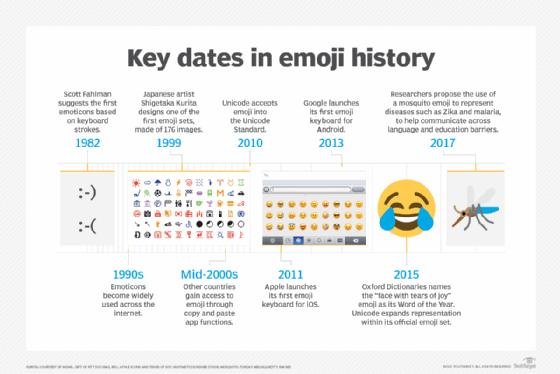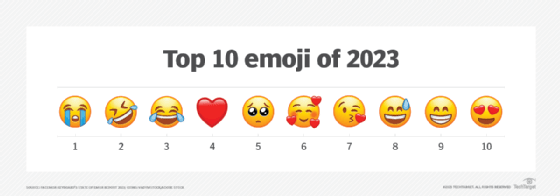
Getty Images
The history of emoji
Emoji have a colorful history. Learn how they evolved from simple emoticons in the 1980s to becoming Oxford Dictionaries' Word of the Year in 2015.
Emoji have become ubiquitous in modern text-based communication. They are beloved for their cute designs and their ability to convey specific ideas and messages in a conveniently concise graphic.
But as culture develops, so, too, do the applications and popularity of specific emoji. In 2015, the "face with tears of joy" emoji became the official Oxford Dictionaries' Word of the Year.
It's not just teenagers and millennials who deploy emoji. Corporate communications are increasingly adopting the more informal medium of communication, while older generations pepper their texts and posts with these images. The White House even included emoji in an economic report about millennials in a clear attempt to connect with the demographic.
While different groups of people might be drawn to different emoji or attach different meanings to them, it seems like everyone is using them in one way or another.
Inserting an emoji into a message or written piece is an easy way to create some levity and break up lines of straight text. As many online platforms become increasingly visual, an emoji can infuse a block of text with something eye-catching and stimulating. Each year, new emoji are added to the mix to reflect cultural shifts and keep them relevant to modern conversation.
For something that has become a staple of daily communication, the origin of emoji is rather unknown. To fully understand their place in today's world, it is important to understand what they are and where they came from.
What is an emoji?
Individually, an emoji is a small image that represents an idea, emotion, symbol or object. It is embedded within a text field and used to convey meaning as an alternative to text. Users might select an emoji for visual differentiation, to say something hard to describe in text-based language or as a shorthand. For example, people might use the "smiling face with heart-eyes" to convey that they love the look of something. Some communities or relationships might attach meaning to certain emoji and use them to showcase their closeness in the same way that people use nicknames or inside jokes.
Together, emoji make up a kind of language. They can be used in combination with each other to represent more complex ideas or messages, much like the ancient Egyptians used hieroglyphics. This language is continually evolving into a more comprehensive one, thanks to the consistent addition of new emoji as well as the refining and expansion of existing ones -- such as adding different genders and skin tones for people-based emoji.
Precursors to emoji
The emoji used today did not appear out of nowhere, but instead arose from an earlier graphic language: emoticons. These are little pictures that are made from combining punctuation marks and other symbols that were readily available on keyboards.
Scott Fahlman, an American computer scientist and professor emeritus at Carnegie Mellon University, is credited with suggesting the first-ever emoticons:
- :-) to convey a joke.
- :-( to convey seriousness.
Fahlman originally shared this idea on a Carnegie Mellon message board, in a post sent Sept. 19, 1982. This shows that computer users have been deploying visual languages long before iPhones and other smartphones popularized the use of emoji.
Emoticons were commonly used on message boards, online chat rooms and other digital forums throughout the 1990s. These were more informal spaces that benefited from emoticons' cuteness and sense of humor. Some emoticons became quite advanced, with many symbols being used in conjunction to create detailed pictures. One of the most well-known examples of this is the "shrugging man":
¯\_(ツ)_/¯
While many people still deploy the most basic emoticons in modern texting due to their ease of use, in general people are moving toward more dynamic emoji. Emoticons are monochromatic and less visually detailed, making them less exciting and communicative than their newer counterparts.
History of emoji
Some of the earliest emoji are attributed to Japanese artist Shigetaka Kurita, who designed a set of 12-by-12 pixel drawings in 1999. They were created for use on Japan's main mobile carrier, NTT Docomo, specifically on its mobile internet platform, i-mode. The first emoji set counted 176 different images and was predominantly made of up symbols rather than human characters. This collection is now available for viewing at New York's Museum of Modern Art.
The word emoji itself comes from the combination of the Japanese words for "picture" and "letter," reflecting the use of emoji as a new graphic language. From the outset, emoji were created to be used through an emoji keyboard that could be pulled up when typing a message on mobile phones. Emoji could be interspersed within text-based messages to convey information more concisely or to provide additional meaning or sentiment; it is historically difficult to interpret tone when reading a text message.
After the introduction of this emoji collection on NTT Docomo, other Japanese carriers began to create their own emoji. This quickly attracted worldwide attention, with American companies such as Apple, Microsoft and Google wanting in on the action. To make emoji compatible globally, Google petitioned the Unicode Consortium to get emoji recognized so that they could be standardized across the world's operating systems. Two Apple engineers followed up on this petition in 2009, and the Unicode Consortium accepted this proposal in 2010.
The new proposal included 625 emoji -- far more than the original collection of 176. At first, users had to copy and paste emoji from elsewhere on the internet if they didn't have one of the original Japanese emoji keyboards installed, but this soon changed. Apple expanded emoji use further with its dedicated emoji keyboard for iOS in 2011, and Android followed in 2013.
Since then, the Unicode Consortium has approved new emoji each year. To get an emoji approved, designers must submit a formal proposal to the consortium that explains why the emoji should be introduced and how it should look. A committee meets regularly to review these proposals, and the approved proposals are eventually launched to the world.
Anyone can submit a design proposal, but there were concerns that some voices were being heard more than others, which led to the Unicode Consortium diversifying its emoji in 2015. The new emoji included male and female characters for each professional emoji, instead of just men; different skin tones for each person-based emoji; and same-sex couples. Since then, the consortium has also added a gender-neutral character option and more representation for people with disabilities.
Most recently, some companies have developed emoji into three-dimensional images and filters, such as Apple's Animoji. Other examples -- such as Bitmoji and Memoji -- focus on creating emoji out of avatars that look just like the user, for a more personalized experience.

Where are emoji commonly used?
Emoji are readily accessible through keyboards on any smartphone. This means that users can post emoji on any website or digital communication that they access through their phone. Emoji are commonly seen across iMessage, SMS text messaging, email and social media platforms.
Emoji have also become available on many office-based instant messaging platforms, such as Slack and Microsoft Teams. Emoji can be sent in their own message or shared as a "reaction" to someone else's message, increasing the options for digital engagement.
Corporate communications frequently include emoji to connect with consumers in their own language, especially when posted on social media sites. Emoji use is a way for organizations to show that they are up to date with culture and understand their audience. Marketing campaigns and social justice movements might also take up specific emoji to help convey a message or show alignment with a cause in a concise way.
There's one more place to find emoji: Emojipedia. The Emojipedia website was launched in 2013 and functions as an online reference site for emoji, explaining their meaning and common usage. It provides collections of emoji associated with specific events or themes, explains culture-related emoji trends and breaks down emoji news.
Emoji statistics
Emoji have been used globally for more than a decade, and trends have shifted over time. In its "State of Emoji Report 2023," Facemoji Keyboard found that while some emoji are quickly growing in popularity, users are still drawn to many old favorites -- especially those with tears or hearts.
The most popular emoji in 2023 was the "loudly crying face" emoji, which replaced 2022 favorite "face with tears of joy" and pushed it into third place. In second place was the "rolling on the floor laughing" emoji, with fourth place going to the "red heart" and fifth place to the "pleading face" emoji. Of the top five, it's notable that 80% involved tears of some sort. These are the same top five as in 2022.

Emoji use can also reflect cultural events of the period. For the first time, the Argentina flag was one of the top 20 emoji. This is thought to be because Argentina won the soccer World Cup in 2022. It wasn't just Argentina fans who were using the emoji either -- it appeared in the top 10 emoji for both Spain and Italy as well, which are known to be big soccer countries.
Other trends could also be seen across geographical lines. The three English-speaking countries surveyed -- the United States, Canada and the United Kingdom -- all had the "skull" emoji in their top 10, which might be connected to the slang use of the word dead, which is commonly used to convey figurative death from either laughing or frustration. The European countries surveyed -- Spain, France, the U.K., Italy and Russia -- all included the "partying face" emoji in their top 10 too.
Every app surveyed had a No. 1 emoji that involved tears in some form, whether "face with tears of joy," "loudly crying face" or "rolling on the floor laughing face." Even on dating apps, emoji trends consistently favored the ones with tears -- though these were laugh-based. Hinge was the only app to not feature the "red heart" in its top 10, despite being a popular platform for finding romantic relationships.
One new favorite that might be surprising to some is the "moai" or "moyai" emoji, which represents the stone statues found on Easter Island. This emoji can be used in different ways by different people, with some using it as a meme and others simply using it to signify a stoic or deadpan reaction. Either way, its popularity ranked it 13th of all emoji in 2023.








